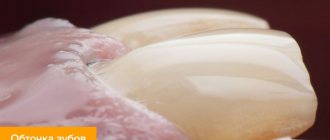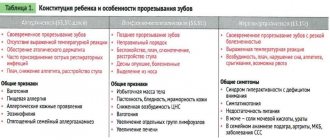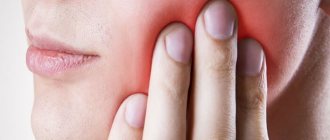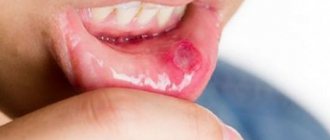Periodontal diseases belong to the group of pathologies of the oral cavity, when hard and soft tissues surrounding the teeth are affected. The periodontium is a retainer that holds teeth in the jaw bones. Its condition affects the health of the entire oral cavity. The main symptoms manifest themselves in the form of bleeding, swelling, and sore gums. Common diseases of periodontal tissue include periodontal disease, gingivitis, and periodontitis.
To alleviate the patient's painful condition, non-surgical treatment is used. For this use:
- Injections;
- Applications;
- Bandages.
As a rule, dentists have ready-made sets of dressings at their disposal, or doctors make their own applications. They are applied to tissues to relieve pain and achieve an anti-inflammatory effect.
Mouthguard for athletes made of silicone
Such mouthguards are used to protect teeth in contact or extreme sports - football, hockey, boxing. Sports mouthguards are worn over the front teeth and reduce the strong physical impact not only on the teeth, but also on soft tissues and even the cervical spine.
Based on manufacturing methods, there are two types of sports mouthguards:
1. Standard sports mouth guard
Sold in any sports stores, made the same for everyone.
2. Individual sports mouth guard.
It is made individually for a specific person using impressions of his teeth, taking into account their anatomical shape. They cost much more, but are also much more convenient, since they fit on the teeth “like family.”
Dental mouth guard
Unlike a sports mouthguard, which is used only for impact protection, a dental mouthguard has a wider range of applications. A dental mouth guard is made from special plastic materials – silicone or polyurethane.
The convenience of the mouth guard is that it can be used to solve many problems - from therapeutic to orthodontic treatment. And at the same time, the mouthguards are convenient to use - the patient can take them off and put them on himself, according to the schedule established by the attending physician.
How to apply a bandage
Before proceeding directly to applying a gingival dressing, consider:
- Presence of anesthetic substances;
- Degree of wound protection;
- Anti-inflammatory effect.
The application process consists of the following steps:
- The doctor professionally cleans the tooth surface, removing deposits;
- The gingival margin is treated with antiseptics;
- After this, the bandage, regardless of its type, is applied so that it fits closely to the gingival margin and cervical part. In this way, periodontal pockets are isolated.
The doctor must make sure that the patient is able to articulate normally. If defects remain after the application of medicinal products, they are corrected: parts that interfere with the person’s ability to speak are cut off.
Duration of wearing from several minutes to three days. Soft bandages are most often used. When a longer period is needed to isolate the wound from the environment, for 3-7 days, rigid/elastic products are used. The procedure can be repeated 2-3 times.
Orthodontic dental guards
These aligners are used to correct malocclusions. At the moment, there are several types of orthodontic aligners on the market from different manufacturers, including Star Smile aligners, the well-known aligners.
But not all orthodontic aligners are capable of solving serious bite problems; they only help to close the spaces between the teeth and correct minor curvatures.
Much has changed when Russian-made orthodontic mouthguards or aligners from the Star Smile company appeared; they became serious competitors to braces, since they can correct almost all defects in the development of bite.
Children's mouth guards for proper teething
These are silicone overlays for teeth, which are also called, among others. retainers, trainers. They are called teething mouthguards because they are most often used during the period of change of baby teeth to molars in children aged six to ten years.
The main purpose of teething trays or teething guides is to correct the position of the jaws and align the position of the child’s incisors during the period of early mixed dentition. They are worn for several hours during the day and all night while sleeping. The treatment period is approximately one year; during treatment, it is necessary to periodically visit an orthodontist to monitor the changes occurring.
Also, during the period of mixed dentition, children's aligners are used - children's orthodontic aligners. Since 2022, such mouthguards have been produced by the Star Smile company.
Teeth whitening trays
There are at-home teeth whitening systems that also use dental trays. Whitening trays can be customized, standard, or disposable. Before using any whitening system, you should visit your dentist to determine what is right for you and will not harm your tooth enamel.
An individual mouthguard is made personally for the patient based on impressions of his teeth. For whitening, a special gel is used that is placed inside the tray.
Whitening at home usually takes longer than at the dentist's office because the gel used at home contains less hydrogen peroxide.
The whitening procedure should be carried out strictly according to the instructions provided. The gel is placed on the inside of the mouth guard, after which the mouth guard is put on and specially pressed to distribute the gel evenly. After putting it on, rinse your mouth with water and wear the mouthguard exactly as long as the instructions say. After removing the whitening tray, you should also rinse your mouth with water.
Gels for self-application on teeth and gums
Gels intended for home applications comprise at least two different groups.
Gels containing fluoride
(up to 4000-12000 ppm fluoride ions), used
for applications to teeth
in order to intensify their secondary mineralization, remineralization and increase the resistance of enamel to acids. Often the gels are acidified, since the incorporation of fluoride into the enamel occurs more actively in a slightly acidic environment. They can be intended for individual use at home or for use in a dental office (Fig. 7). Thus, these means of local caries prevention relate to both personal dental care and medical dental prophylaxis.
Fluoride gels available for self-use
include neutral sodium gel (5000 ppm), stannous fluoride gel (1000 ppm). 1.23% sodium fluoride acidified phosphate gel (APF) has become widely used. Below is the classic composition of such a gel:
- sodium fluoride - 26.50 g
- sodium phosphate (dibasic) - 10.00 g
- phosphoric acid 50% (until pH = 3.2 is reached)
- 11.00 ml
- sodium carboxymethylcellulose - 28.00 g
- sodium saccharin - 500.00 mg
- flavoring – 10.00 ml
- distilled water - up to 1 l
In some European countries, topical gels are used as part of mandatory dental brushing programs (6–12 times a year) or are recommended for weekly home use in persons over 8 years of age. The concentration of fluoride in self-administered products is lower than that in products intended for professional use.
Applications are usually carried out not daily, but at certain intervals.
To carry out the application, the gel is applied to the teeth using a toothbrush or applicator for several minutes, after which the mouth is thoroughly rinsed. Application with gel applied to an impression tray or a special two-jaw plastic tray is more effective and safe. Many companies produce application spoons of various sizes for this purpose. It is more convenient to use individually made spoons. About 2.5 ml (5-10 drops) of gel is usually applied to an adult’s spoon (about 40% of the spoon’s capacity).
Gels for home use, just like toothpastes, can be involuntarily swallowed (according to various sources, from 15 to 100%, on average 30%), therefore the fluoride content in them corresponds to that in traditional fluoride-containing toothpastes. Gels with a high fluoride content can only be used in a clinical setting under the supervision of a physician and using a saliva ejector.
The duration of the application should not exceed 4 minutes. If you have porcelain dentures in your mouth,
which can be destroyed by acidic solutions and gels, they should be isolated (lubricated with Vaseline) before application. Before applying the gel, you must brush your teeth, 30 seconds after application, rinse your mouth with water or a saturated sodium bicarbonate solution, and do not drink or eat for 30 minutes.
Fluoride gels for individual and medical use are indicated in case of high intensity of caries, the presence of general and local cariogenic factors (in particular, according to WHO recommendations, orthodontic patients and in patients with xerostomia who are undergoing radiation therapy), the presence of foci of enamel demineralization on the teeth, and dental hyperesthesia.
Gels intended for application to the mucous membrane of the gums,
represent an extremely small group. These, in particular, include drugs with antiseptic and anti-inflammatory additives used before and after periodontal surgery.
This group also includes Oralbalance Gel, containing lactoperoxidase, glucose oxidase and xylitol. Like Biotene toothpaste, the gel replenishes the normal protective properties of saliva, reducing bacterial contamination. Due to the content of polyglyceryl methacrylate, the gel moisturizes tissue and is recommended for use in cases of xerostomia. The gel is applied to the tongue and gums. It is not recommended to combine with detergents.
Parodium gel (Pierre Fabre, France) contains chlorhexidine digluconate (0.02 g), Tangut rhubarb extract, which has an anti-inflammatory effect (0.20 g), formaldehyde (0.10 g) and is applied with a finger or a special applicator to the gums 3 times a day. day for the prevention and treatment of periodontal diseases.
Dentim-gel (Mirra, Russia) contains biologically active substances isolated by cold extraction and biotechnological potentiation from a special collection of medicinal plants, lavender essential oil, and alcoholic extract of sweet clover. The gel has antibacterial, anti-inflammatory and deodorizing effects and is recommended for application and gentle rubbing into the gums for preventive purposes in the presence of inflammatory processes in the periodontium.
Applications on teeth using trays
These mouth guards are used to restore and strengthen tooth enamel. A special composition is placed inside the mouthguard, thanks to which the teeth are remineralized.
There are two types of mouth guards for dental applications – standard and thermoplastic.
Thermoplastic ones react to heat and soften when placed in hot water, and harden when put on the teeth.
Gels containing fluorides (up to 4000-12000 ppm fluoride ions),
used for applications to teeth in order to intensify their secondary mineralization, remineralization and increase the resistance of enamel to acids. Often the gels are acidified, since the incorporation of fluoride into the enamel occurs more actively in a slightly acidic environment. They can be intended for individual use at home or for use in a dental office (Fig. 7). Thus, these topical caries prevention products are classified as both personal dental care products and medical dental prophylaxis products. Fluoride gels available for self-use include neutral sodium gel (5000 ppm), stannous fluoride gel (1000 ppm). ppm). 1.23% sodium fluoride acidified phosphate gel (APF) has become widely used.
Below is the classic composition of such a gel:
- sodium fluoride - 26.50 g,
- sodium phosphate (dibasic) - 10.00 g,
- phosphoric acid 50% (until pH = 3.2 is reached) - 11.00 ml,
- sodium carboxymethylcellulose - 28.00 g,
- sodium saccharin - 500.00 mg,
- flavoring – 10.00 ml,
- distilled water - up to 1 liter.
In some European countries, topical gels are used as part of mandatory dental brushing programs (6–12 times a year) or are recommended for weekly home use in persons over 8 years of age. The concentration of fluoride in products used independently is lower than their concentration in products intended for use by specialists. Applications are usually carried out not daily, but at certain intervals. To carry out the application, the gel is applied to the teeth using a toothbrush or applicator for several minutes, after which the mouth is thoroughly rinsed. Application with gel applied to an impression tray or a special two-jaw plastic tray is more effective and safe. Many companies produce application spoons of various sizes for this purpose. It is more convenient to use individually made spoons. About 2.5 ml (5-10 drops) of gel (about 40% of the spoon's capacity) is usually applied to an adult's spoon. Gels for home use, as well as toothpastes, can be involuntarily swallowed (according to various sources, from 15 to 100% , on average 30%), therefore the fluorine content in them corresponds to that in traditional fluoride-containing pastes. Gels with a high fluoride content can only be used in a clinical setting under the supervision of a physician and using a saliva ejector. The duration of application should not exceed 4 minutes. If there are porcelain dentures in the mouth, which can be destroyed by acidic solutions and gels, they should be isolated (lubricated with Vaseline) before application. Before applying the gel, you must brush your teeth, 30 seconds after application, rinse your mouth with water or a saturated solution of sodium bicarbonate and do not drink or eat for 30 minutes. Fluoride gels for individual and medical use are indicated for high caries intensity, the presence of general and local cariogenic factors (in particular, according to WHO recommendations, orthodontic patients and in patients with xerostomia who are undergoing radiation therapy), the presence of foci of enamel demineralization on the teeth, and dental hyperesthesia.
Mouthguards for night teeth grinding
Bruxism or nighttime teeth grinding is one of the serious diseases that affects approximately 3% of the world's population. The reasons for this have not been fully identified, but the consequences can be very serious - from abrasion of tooth enamel to deformation of the jaw joints. Wearing special mouth guards allows you to protect your teeth from premature wear, relieve muscle tension, and reduce headaches. For the effect to be effective, the mouth guards should be worn for up to 10 hours a day.
Mouthguards for the treatment of teeth grinding are distinguished by the time of their use. There are day guards that are worn during the day; they are transparent and almost invisible.
There are night guards that you wear while you sleep. They may differ in shape from daily mouth guards, but are also comfortable and imperceptible in the mouth.
How to strengthen gums at home
To strengthen your gums at home, you can use traditional medicine.
- Rinse your mouth with salted water, which will quickly improve the condition of your gums.
- Sauerkraut with a high content of vitamin C ideally cleanses the oral cavity and strengthens the gums.
- If periodontal disease is in its early stages, a mixture of honey and salt will help strengthen your gums. Mix 10 g of table salt in 20 g of honey and rub the gums with the resulting mixture.
- Once a day, you can rub your gums with olive oil and sea salt. This product not only helps strengthen your gums, but also whitens your teeth.
- Garlic is very helpful in strengthening gums. You need to chew one clove of garlic and spit it out. To get rid of the garlic smell, chew parsley root or greens.
- Make it a rule to rinse your mouth with a solution of sea salt every day after each meal. Dissolve a spoonful of sea salt and a few drops of iodine in 200 ml of warm water.
Please note that traditional medicine can only be used as an additional treatment for gums. At the slightest pain in the gums, their swelling or bleeding, you should immediately contact your dentist and it is good if this is a doctor with whom you are a regular patient, and undergo an annual dental check-up.
Retainer or mouthguard
After aligning the bite using braces or aligners, you must wear a special mouth guard or retainer that secures the result. In appearance, this tray looks like an aligner, only very, very smooth and even.
Retention aligners are made from special biopolymers; they are easy to use and almost invisible. These mouth guards are worn at night and worn for several hours during the day. The timing of wearing retainers is individual and depends on the degree of development of the malocclusion.
Wearing retaining trays after braces and aligners is mandatory, and this is the only way you can be sure that the teeth will not return to their original incorrect position.
Basic rules for gum care
To maintain teeth and healthy gums, you must follow several rules:
- General oral and dental hygiene should not last less than 5 minutes. You should brush your teeth three times a day.
- The gums usually begin to hurt at the base of the tooth, in the place where plaque has formed on the tooth. To prevent the formation of plaque, the teeth at the base must be cleaned with a rotating movement of the toothbrush so that its bristles penetrate into the interdental space and clean the gum at the entrance of the tooth.
- Your toothbrush should be changed every three months, and after the last brushing of your teeth, soak the brush in a disinfectant solution overnight.
- When brushing your teeth, be sure to clear your tongue of plaque. The fairly loose tissue of the tongue is a favorable environment for the proliferation of pathogenic bacteria.
- If for any reason you are unable to brush your teeth, then you need to prepare an aqueous solution with baking soda or table salt.
Dental elixirs, which are made from extracts of medicinal herbs, help take care of your teeth. Such elixirs help to effectively clean the mouth and teeth.
Luminous decorative burls
Here manufacturers have a wide range of options, as they say - for every taste and color. And even light, which, thanks to technology, is now built into mouth guards.
Of course, in this case we are not talking about the benefits of mouth guards, but about entertainment. You can wear them to a disco or surprise others at a friendly party.
How to care for your mouthguards
Typically, mouthguards do not require special care. Modern dental mouth guards often just need to be rinsed with running water. Less often they need to be cleaned with toothpaste and a brush. When using orthodontic aligners, the doctor will definitely advise you on how to care for them.
Sports mouthguards require slightly different care and are stored in separate containers and periodically placed in a special solution to extend their life. Any sports mouthguard comes with its own instructions for use and care.
Application trays have their own service life and, as a rule, are not designed for long-term use.
It is enough to wash decorative mouth guards after use under running water, or, in extreme cases, with soap or brush them with a toothbrush.
How to purchase a mouth guard for dental protection or treatment
Standard sports mouthguards can be purchased at almost any sports store. If you are trying to find a quality product, then you should read reviews on various forums or contact a dentist to have custom mouth guards made. This is what all professional athletes do.
Mouthguards for teeth whitening and treatment of certain diseases can be purchased at the pharmacy. But before starting use, it is still better to consult an appropriate doctor to evaluate all possible treatment options and choose a safer and more effective one.
It is better to order mouth guards for teeth straightening individually from well-known and trusted manufacturers, so as not to waste money and not cause more harm to your health.
Gels intended for application to the mucous membrane of the gums,
represent an extremely small group. These, in particular, include drugs with antiseptic and anti-inflammatory additives used before and after periodontal surgery. This group also includes Oralbalance Gel, containing lactoperoxidase, glucose oxidase and xylitol. Like Biotene toothpaste, the gel replenishes the normal protective properties of saliva, reducing bacterial contamination. Due to the content of polyglyceryl methacrylate, the gel moisturizes tissue and is recommended for use in cases of xerostomia. The gel is applied to the tongue and gums. It is not recommended to combine with detergents. Parodium gel (Pierre Fabre, France) contains chlorhexidine digluconate (0.02 g), Tangut rhubarb extract, which has an anti-inflammatory effect (0.20 g), formaldehyde (0.10 g) and is applied with a finger or special applicator on the gums 3 times a day for the prevention and treatment of periodontal diseases. Dentim-gel (Mirra, Russia) contains biologically active substances isolated by cold extraction and biotechnological potentiation from a special collection of medicinal plants, lavender essential oil, alcoholic extract of sweet clover. The gel has antibacterial, anti-inflammatory and deodorizing effects and is recommended for application and gentle rubbing into the gums for preventive purposes in the presence of inflammatory processes in the periodontium.
If you find an error, please select a piece of text and hold LEFT Ctrl and press Enter.
You can send no more than 5 messages in 30 minutes!
Liked? Tell your friends!









